Boston in American History
Since we're from the west we're more familiar with western
history -- the Oregon Trail (1841), the California gold rush (1849) and
the shoot-out at the O.K. corral (1892). In the west we traveled
through towns with buildings dating in the early 1900's and once in awhile
in the late 1800's. Compared to the East Coast, western accomplishments
and "historic" sites seem recent to us now.
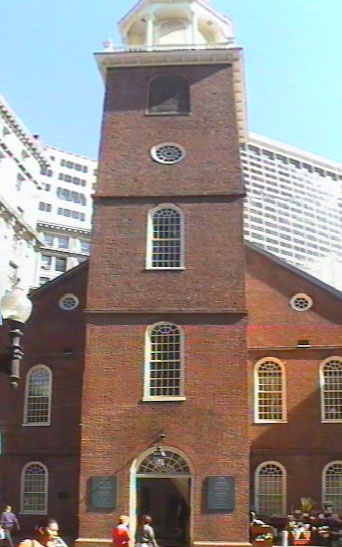 |
We've been studying American History with the kids ever
since we started traveling. We've learned that the patriots of Boston were
the ones that sparked the Revolutionary War, so we were anxious to see
the sites here.
This is the Old South Meeting House in Boston, built in
1729 as a Congregational Church. Both the exterior and interior have
been beautifully preserved. The pews have been marked with the names
of it's regular parishioners, (General George Washington among them).
As it was the largest church in Boston, it also served
as the town's meeting hall. It was here, on December 16, 1773, that
a meeting was held to discuss the British tax on tea and the continuing
problems the Colonists were having with the Mother Country.
During the Revolutionary War, the British took over and
occupied Boston. To insult the locals, the British tore out the lower
seating area and turned the Old South Meeting House into a horse stable
and riding arena, with view seating on the sides and balcony. After
the war, the Boston residents restored the hall to a church and meeting
hall. |
I'll bet most of you are like me -- I can tell you
that "American History" is a required class in high school. If you
read the questions at the end of the chapter in the text books you can
get most of the answers for homework and the tests. I focused on
math, science, electronics, computing and extra curricular topics that
I won't go into here, so History to me was really a lot of "sound bytes"
-- you know; "Columbus", "the Pilgrims", "the Revolutionary War", "the
Cumberland Gap", "the Louisiana Purchase", "the Civil War", "the Oregon
Trail", "the Tennessee Valley Authority" and on and on -- a bunch of familiar
sounding words with no depth.
As we drive, Cheryl often reads history to the kids.
We have a thirteen volume set entitled "The Making of US", by Joy Hakim.
It's written more as stories rather than a textbook. (Wow, what a concept
-- stories that teach!) We are getting the in-depth story prior to
visiting the historic places we read about. It makes places like
Boston, Philadelphia, Washington, D.C., etc. so much more meaningful.
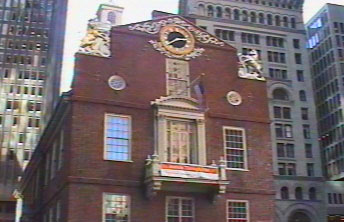 |
So, we've become real "history nerds" -- now we ponder
very unusual things, like:
-
How communication occurred between Boston and Philadelphia
with limited roads, if any, and treacherous seas.
-
We find it interesting that Benjamin Franklin and Samuel
Adams grew up together in Boston. Sam was instrumental in firing
up the crowd to start the Revolution, (but did not own a brewery).
Ben Franklin was a statesman and diplomat that ended up in Philadelphia
but was just as instrumental in the Revolution.
-
How did the British and the Colonists, in the middle of the
war, stay divided by a river for weeks?
|
First I thought I'd try to capture the details that make
the American Revolution so interesting -- the forces and human motivation
that brought about a remarkable government that had never been tried in
the civilized world. But guess what? It'd take longer than
I have to write and longer than you have to read. Besides, reading
about it without gaining the understanding obtained by a personal visit
just won't create the same experience.
The picture above is The State House. It is the
original home of the King's appointed British Governor who oversaw the
Colony of Massachusetts. It was in front of this building that five
Colonists were shot by British soldiers in what is known as "The Boston
Massacre". The "Massacre" sounds like it started out a lot like the
World Trade talks in the Seattle last year, (only no shots were fired in
Seattle). It happened five years before the start of the Revolutionary
War. A crowd became unruly and harassed a small group of British
soldiers. A shot was fired, (no one knows from who), and that started
a skirmish in which five Colonists died. Regardless of who was right
or wrong, it was a step toward uniting the Colonists against the British.
By using a lot of press and exaggeration, Sam Adams used this event to
paint a brutal picture of the British soldiers and the Crown's rule.
|
Bunker Hill Memorial
Ranger Gagnon at Bunker Hill National Historic Site provided
the best talk we've ever heard at a National Park. He described how
tensions led to the Boston Massacre, the Boston Tea Party and the Battle
at Lexington and Concord.
After the Battle at Lexington and Concord the British
closed the Boston Harbor and occupied the peninsula, (which was the entire
city of Boston). Since no fort or barracks existed in Boston, one
or two British soldiers moved in with each Boston household. (That'd
be like one IRS agent and one FBI agent moving in and living in your house
with you and your family).
|
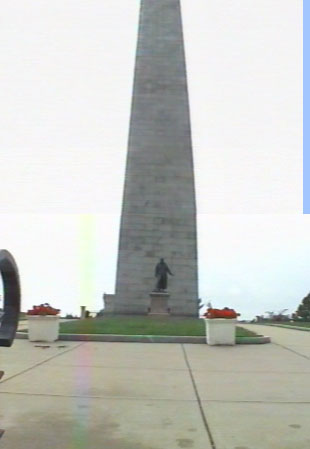 |
Bunker Hill and Breeds Hill across the river to the north
and another hill across the water to the south, would provide an advantage
to the British if they occupied them. As Ranger Gagnon put it, with
the high point advantage they could move from both the South and the North
and wipe out the "Colonial rats nest" to the east in Concord.
Well, to continue simplifying this story, word got to
Concord that the British were planning to move on the hills. So the
Colonists organized as best they could. Quietly, in the middle of
the night, they moved on to the hill in Boston. They dug quietly through
the night using shovels, sticks and even their hands to make an earthen
battle line. When dawn came, both the Colonists and British could
not believe their eyes. The Colonists saw that they set up too close
to shore and within reach of British naval cannons. The British saw
that there was suddenly a Colonial fortification looking down on them.
It took the whole morning for the British to rally together so by noon
the Colonists had further fortified their position.
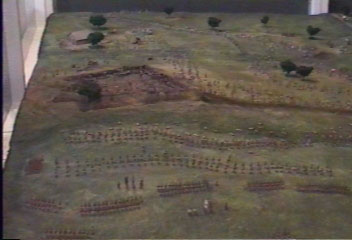 |
Here is a diorama of the Bunker Hill Battle. The
Colonist are seen in the background, the British in the foreground.
The earthen birm and fence runs toward the river with half of it shown
here. The British had assumed that the Colonists were no match for the
world's most powerful military force.
"Don't fire until you see the whites of their eyes" was
the command given the Colonists as the British charged. They had
to make every shot count. Their supply of gunpowder was small and
they only had muskets they had brought from home. After hours of
fighting, the Colonists ran out of gunpowder, retreated and ultimately
lost the hill. |
Though they lost the battle, the causalities were shocking
-- one to four in favor of the Colonists. The British had lost a
third of their entire force in the colonies. The British ego was
devastated by their huge losses. This battle displayed to the Colonists
that battling the British was possible.
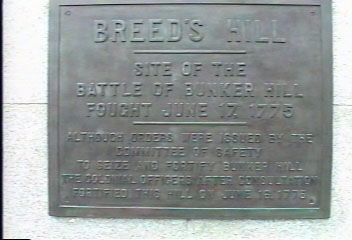 |
Breeds Hill
The Battle of Bunker Hill was actually fought on Breeds Hill,
(which is just in front of Bunker Hill). The Colonists planned to set up
on Bunker Hill, but in the dark of the night they traveled past Bunker
Hill to Breeds Hill. This hill looked like a better spot to look
down on Boston.
|
This celebrated battle that the Colonists fought and lost
was in the wrong place. It was however, the first large battle of
the Revolutionary War and is known today as "the shot heard around the
world".
| Here's a monument to Paul Revere and the famous steeple
of the Old North Church in the background. Well, everyone has heard
of Paul Revere and his famous ride, but we never hear about Billy Dawes
and Dr. Samuel Prescott. All three of the men set out on the night
of April 17, 1775 to warn the Colonists at Concord that the British were
coming. |
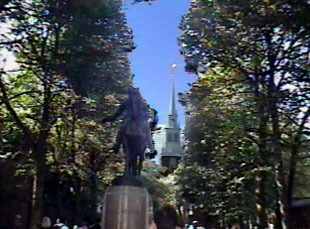 |
The British were planning to capture the cache of Colonial
arms and gunpowder stored in Concord and to locate Sam Adams and John Hancock
who were considered high treasonists by the British. The events of
that evening provide a great story and all three men carried out their
roles successfully to warn Concord.
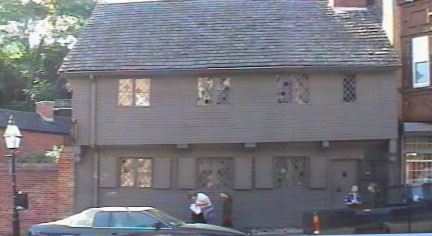 |
But then why is this simple house, the house of Paul
Revere, preserved today and not Billy Dawes and Dr. Prescott's? Well,
it wasn't until the Civil War that Paul Revere actually became famous.
Henry Wadsworth Longfellow was troubled in the mid-1800's when he could
see that the nation was be split apart by the threat of a civil war.
He had heard about a fellow named Paul Revere and his role in notifying
the Colonists at Concord. He was touched by the story and the way
in which the Colonists had pulled together to create our nation. |
He wrote the poem of Paul Revere's Ride in an effort to remind
us to stand together around the principles that formed our country.
So today Paul is famous and the others aren't. Paul was a silver
and coppersmith. Paul's descendants continue an interest in the family
business known today as Revereware.
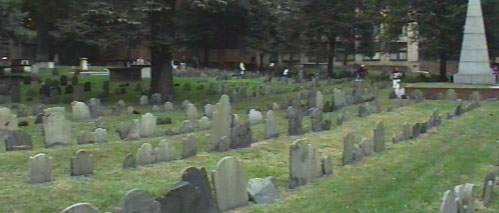 |
There are several cemeteries in downtown Boston. As we
drive along the east coast, we notice many more small cemeteries, usually
in the side yards of neighborhood churches, than in the western states.
In some areas, especially near the coast, it seems like there's one every
other block. |
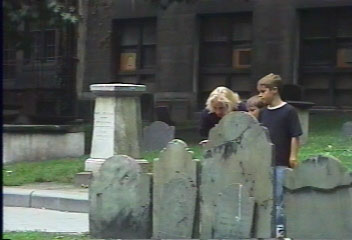 |
Walking through this cemetery is like reading a history
book. Many of the early Patriots are buried here. |
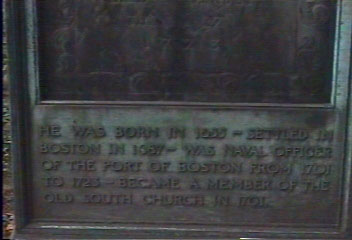 |
I was impressed with the dates and stories on many of
the tombstones. Here's just one example. Remember, the Pilgrims
landed in 1620 and the Revolutionary War started in the 1770's.
HE WAS BORN IN 1655 - SETTLED IN BOSTON IN 1687
- WAS NAVAL OFFICER OF THE FORT OF BOSTON FROM 1701 TO 1725 - BECAME A
MEMBER OF THE OLD SOUTH CHURCH IN 1721
|
Here's a few more people that are buried here.
(The words are from a tourist plaque).
James Otis, 1725-1783. Legal scholar and outspoken Stamp
Act critic. Of his fiery speeches John Adams stated, "American independence
was then and there born."
Victims of the Boston Massacre, 1770. Here lie the first
colonist killed by british troops.
Crispus Attucks, first to die, was of African and American Indian
descent.
Three signers of the Declaration of Independence.
Samuel Adams, 1772-1803: The "Grand Incendiary", powerful advocate
of independence.
Robert Treat Paine, 1731-1814; Prosecutor at the Boston Massacre
trial and Massachusetts' first Attorney General.
John Hancock, 1737-1793; First signer; Governor after independence.
Franklin Family Obelisk, Statesman, author and inventor
Benjamin Franklin was buried in Philadelphia in 1790.
Here lie his parents, his 16 siblings, and a relative of the same name.
"Mother Goose" According to popular legend, Elizabeth Goose
wrote the nursery rhymes printed in 1719 by her son-in-law. Her grave
is uncertain but members of her family are buried here.
Paul Revere, 1735 -1818. Silversmith and engraver. Rode
to Lexington to warn Hancock and Adams of the British advance. His
rolling mill made copper to cover the State House dome.
Samuel Seawall, 1652 1730. Chief Justice of the colony
(1718-1728); foe of slavery and the only judge of the Salem Witch Trials
to later denounce 19 death sentences.
Peter Faneuil, 1700 -1743, Faneuil Hall was a gift to Boston
from this wealthy merchant.
John Smibert (1688-1751), Fanueil Hall's designer, is also
buried in Granary, in an unmarked grave.
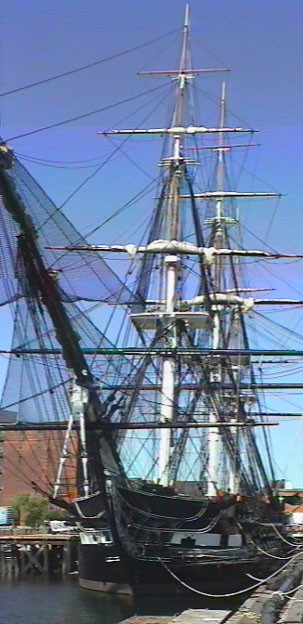 |
The U.S.S. Constitution, "Old Ironsides"
|
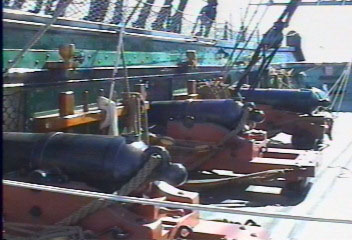 |
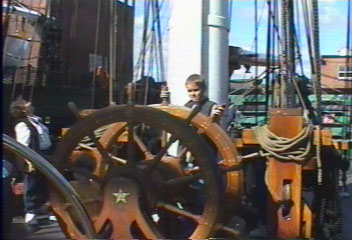 |
Mitch takes the helm. |
| Below on the cannon deck is an impressive array of firepower.
This ship is solid cannon from bow to stern. |
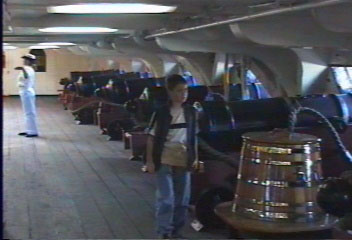 |
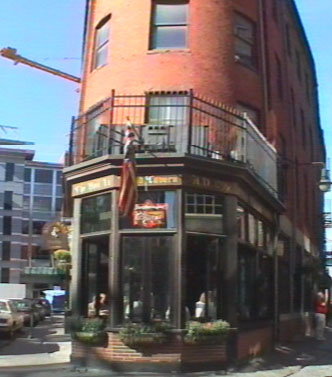 |
The Bell In Hand Tavern, 1795
America's Oldest (still operating) Tavern
According to the date, this tavern was not in business
at the time of the Revolutionary War, but it's been in operation for an
awful long time.
The local taverns were the places to discuss business
and politics. Since there was no postal service, (until Benjamin
Franklin started one), the mail was dropped off at the local tavern and
distributed there.
|
ã
copyright Nodland 1999-2020














